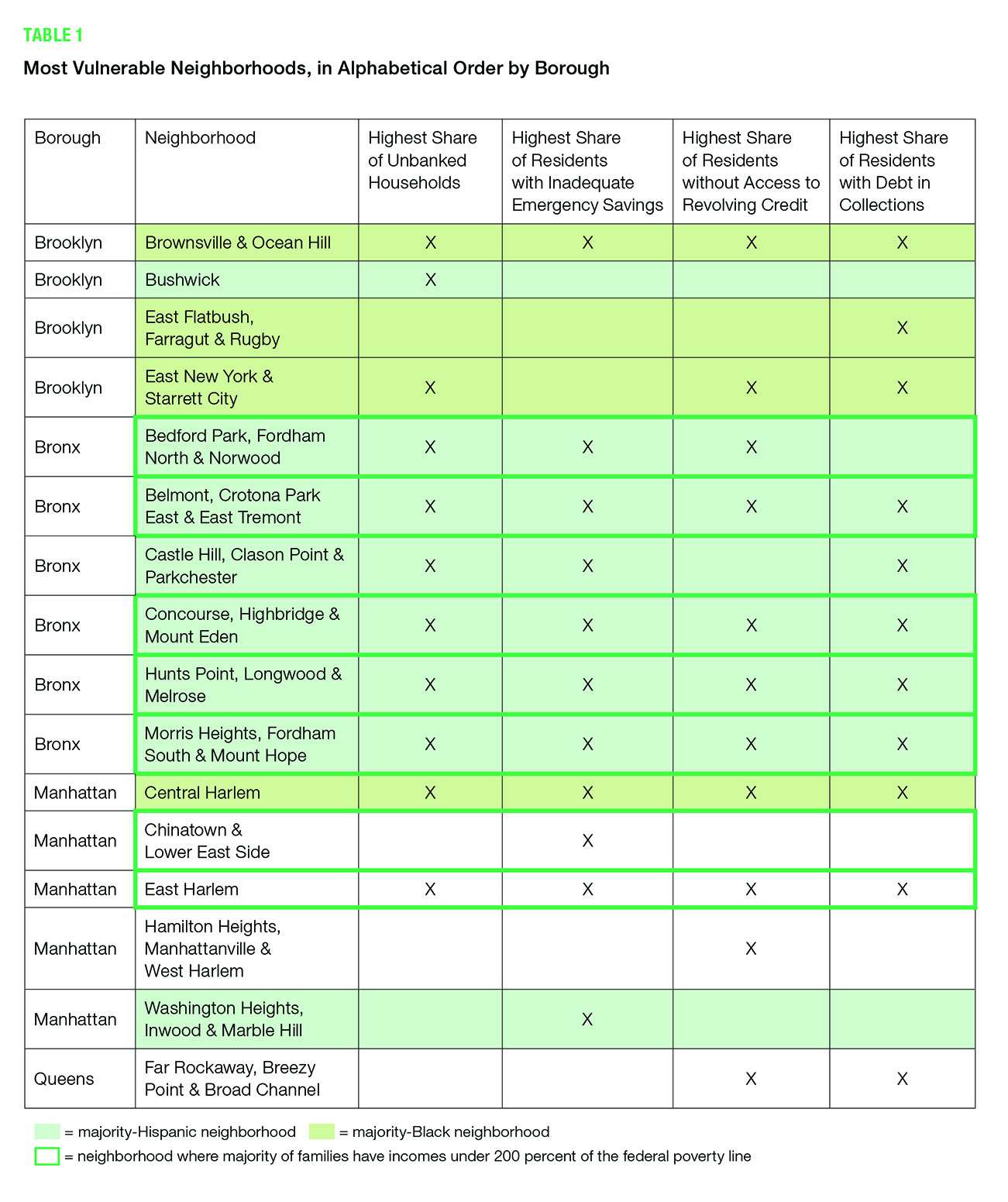October 8, 2020
NEW YORK, NY – Department of Consumer and Worker Protection (DCWP) today released Already At-Risk: The New Yorkers Struggling Economically Before COVID-19, a research brief examining the financial vulnerability of New Yorkers prior to the COVID-19 crisis to understand who is least able to cope with its economic effects. The research brief looks at three key indicators of financial health—banking access, emergency savings, and credit access—to identify the most vulnerable neighborhoods prior to the pandemic and who is therefore most vulnerable now and to future economic shocks. The brief finds that the most financially vulnerable New Yorkers live in south and central Bronx, northern Manhattan, and eastern Brooklyn—neighborhoods that also have higher shares of Black and Hispanic households and households with low incomes. This is the first of two briefs about the economic effects of the COVID-19 crisis.
“Our findings not only show who is financially struggling the most right now, but they yet again point to the inequities at the root of that hardship. Not only are many of these New Yorkers up against long-standing racial wealth, pay, and employment disparities, COVID-19 then took a toll on their physical health when their neighborhoods were hardest hit by the virus,” said DCWP Commissioner Lorelei Salas. “And now—without a bank account to easily receive unemployment or stimulus payments, no savings to serve as a cushion, and no access to credit to help cover expenses—their financial health is precarious to say the least. These New Yorkers need the federal government to step up with real relief and real community empowerment policies that solve these systemic issues that continue to plague our neighborhoods.”
The table below shows the most vulnerable neighborhoods for our three key indicators of financial resiliency. Of the 55 neighborhoods in New York City, 16 neighborhoods scored in the top 20 percent of neighborhoods for one or more of the indicators:
- Seven of the 16 neighborhoods were in the top 20 percent of neighborhoods for all four indicators.
- All but four of the 16 neighborhoods are majority-Black or majority-Hispanic.
- In seven of the 16 neighborhoods, the majority of households have incomes under 200 percent of the federal poverty line.

The brief encourages conversations to address the challenges of the 11 percent of unbanked New York City households, 49 percent of New Yorkers without adequate emergency savings, and 38 percent of New Yorkers lacking access to revolving credit. The City is already starting to take steps to address these concerns. Recognizing the racial pattern of COVID-19 cases and the uneven impact of the rapid job loss resulting from the pandemic, Mayor Bill de Blasio appointed a Taskforce on Racial Inclusion & Equity to engage the hardest-hit communities—including many of the communities identified in this brief, with the goal of narrowing long-standing racial and economic disparities.
In addition to building awareness and advocating for policies and systems that provide opportunity and access for all New Yorkers, DCWP’s Office of Financial Empowerment (OFE), is committed to providing services that help to improve the financial health of New Yorkers. DCWP encourages anyone who experienced a change in income and needs help creating a realistic budget, opening a bank account, or managing debt to make an appointment with a professional financial counselor at an NYC Financial Empowerment Center. Anyone who lives or works in New York City, can book an appointment for free, one-on-one financial counseling—which is currently mostly available via phone—at nyc.gov/TalkMoney or by calling 311.
NYC Department of Consumer and Worker Protection (DCWP) protects and enhances the daily economic lives of New Yorkers to create thriving communities. DCWP licenses more than 59,000 businesses in more than 50 industries and enforces key consumer protection, licensing, and workplace laws that apply to countless more. By supporting businesses through equitable enforcement and access to resources and, by helping to resolve complaints, DCWP protects the marketplace from predatory practices and strives to create a culture of compliance. Through its community outreach and the work of its offices of Financial Empowerment and Labor Policy & Standards, DCWP empowers consumers and working families by providing the tools and resources they need to be educated consumers and to achieve financial health and work-life balance. DCWP also conducts research and advocates for public policy that furthers its work to support New York City’s communities. For more information about DCWP and its work, call 311 or visit DCWP at nyc.gov/dcwp or on its social media sites, Twitter, Facebook, Instagram and YouTube.
REMINDER:
It is critical that all New Yorkers are counted in the 2020 Census. New York City stands to lose billions of dollars in federal aid every single year for schools, hospitals, health clinics, affordable housing, transportation, and more, as well as its fair share of representation in Congress. The census is easy, safe, and confidential. It is just 10 simple questions that can be answered in under 10 minutes either online or by phone. There are no questions about immigration, citizenship, criminal history, or income. Visit
my2020census.gov or call 844-330-2020 to complete your census today.

 Consumer and Worker Protection311
Consumer and Worker Protection311 Search all NYC.gov websites
Search all NYC.gov websites



